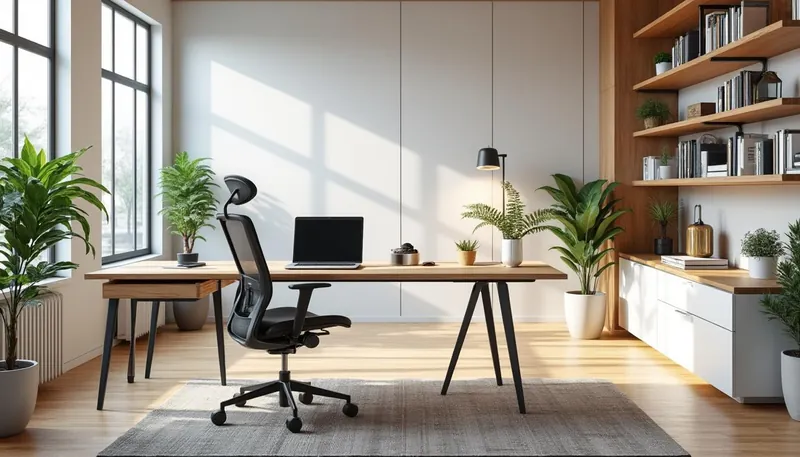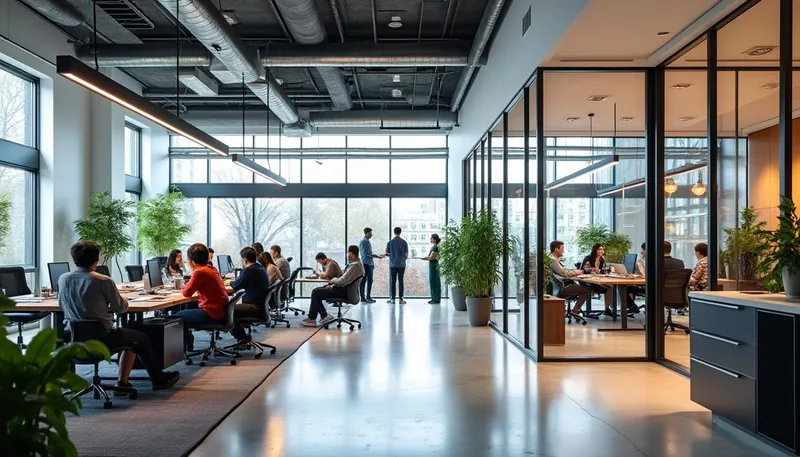Creating a branded office design that balances aesthetics and functionality is no small feat. It’s crucial to strike the right chord between subtlety and expression to project your company’s identity effectively. In today’s competitive landscape, an office is not just a workspace; it’s a canvas to showcase your brand. Let’s delve into various strategies for integrating branding into office design without overdoing it, ensuring your environment resonates with your values while avoiding an overwhelming display of corporate identity.
Brief
- Defining brand identity before design is crucial for coherence.
- Careful selection of brand colors and elements enhances recognition.
- Designing functional spaces reflects company values and culture.
- Engaging professional decorators helps achieve polished results.
- Utilizing lighting and accessories sets the mood without overbranding.
The Importance of Defining Brand Identity in Office Design
Before you start rearranging furniture or choosing paint colors, it’s essential to clearly define your brand identity. What does your company stand for? What personality traits do you wish to convey? These questions are foundational because they shape the design elements that will come later. For example, if your brand promotes innovation, your workspace might benefit from a bold and vibrant aesthetic. In contrast, a more conservative business might thrive in a space that emanates elegance and professionalism.
Consider these factors when defining your brand identity:
- Core Values: What are the principles that guide your company?
- Target Audience: Who do you want to attract?
- Brand Personality: Is your brand quirky, traditional, or innovative?
- Industry Impact: How does your sector influence your branding choices?
- Desired Atmosphere: Do you want a lively, collaborative space or a quieter, focused environment?
Once you define these elements, it becomes easier to translate them into your office design. A tech startup might incorporate casual seating areas to foster collaboration, while a law firm might design more traditional, closed meeting spaces to instill confidence and seriousness. The layout itself conveys a message; open spaces imply transparency and teamwork, while cubicles may hint at a more hierarchical structure.
Strategic Use of Branding Colors and Elements
Now that you have a firm grasp of your brand identity, it’s time to think about colors and branding elements. Using your brand color palette strategically throughout your office can significantly impact the overall feel and consistency of the space. Instead of splashing the walls in bright hues, consider incorporating color in a more refined manner.
Here are some tips for using colors effectively:
- Choose a neutral base: This allows your brand colors to pop without overwhelming the senses. 🖌️
- Accent walls: Use your brand colors on one or two accent walls, where they complement the overall aesthetic. 🌈
- Branded furniture: Incorporate furniture pieces that reflect your color palette subtly, such as chairs, tables, or even decorative cushions. 🛋️
- Informative signage: Use brand colors for direction signs or information boards to enhance visibility and communication. 📊
- Art and graphics: Commission artwork that incorporates your brand’s color scheme and values, creating a focus point that tells your story. 🎭
| Color Use | Description |
|---|---|
| Neutral Base | Allows brighter accent colors to shine through without overwhelming the space. |
| Accent Walls | Highlights particular areas of the office and creates visual focus. |
| Furniture | Integrates branding subtleties without shouting it out loud. |
| Signage | Utilizes colors for clarity and ease of navigation within the office. |
| Artwork | Engages visitors and employees with a visual representation of your brand. |
Remember, the key to effective branding is subtlety and balance. Too much color can overwhelm a space and disengage employees, so it’s crucial to find a happy medium that reflects your brand while remaining functional and inviting.
Designing Functional Spaces that Reflect Company Values
Designing your office isn’t just about aesthetics; the layout must also align with your company’s core values. For instance, if your brand emphasizes creativity, you might want to create open areas that encourage spontaneous collaboration. Alternatively, if confidentiality is paramount, having private spaces for meetings and discussions could take precedence.
Here are some ideas to consider when planning your office layout:
- Flexible Workstations: Allow employees to choose their work environment each day by providing a mix of collaborative and quiet spaces. ⚖️
- Breakout Areas: Include comfortable spots for relaxation or informal meetings that inspire creativity. 🧠
- Privacy: Design areas that promote confidentiality, like soundproof meeting rooms. 🤫
- Outdoor Access: If possible, provide access to outdoor spaces for fresh air breaks, encouraging a healthy work environment. 🌳
- Tech Integration: Ensure that technology seamlessly integrates into workspaces to support collaboration, including charging stations and video conferencing tools. 💻
Each space should serve a purpose and tell your brand’s story. For example, at a wellness-oriented company, an open design with plenty of natural light and plants could promote a healthy work culture. On the flip side, a traditional firm may benefit from distinct office spaces that denote formality and professionalism.
The Role of Professionals in Office Design
When it comes to creating that perfectly branded office environment, sometimes you need expert input. Professional decorators and design firms can help create spaces that are functional, visually appealing, and aligned with your branding goals. Their expertise is indispensable in ensuring every detail harmonizes with your brand identity and atmosphere.
Benefits of working with professionals:
- Expertise: They have a deep understanding of design principles and material selection. 🧑🎨
- Functionality: Designers balance aesthetics with practicality, ensuring that the space is not only beautiful but also functional. ⚙️
- Brand Alignment: Professionals ensure that every element—furniture, colors, and layouts—speaks to your brand’s narrative. 📖
- Budget Management: Good designers can help get the best return on your investment by working within your budget. 💰
- Time-Saving: Avoid the pitfalls of DIY design and focus on your business while they manage the project. ⏳
To find the right design firm, consider firms known for their minimalistic approach and understanding of understated branding, such as CleanLine Interiors or Balanced Brand Interiors. These firms can carefully harmonize your office’s visual identity with its functionality without resorting to overly flashy designs.
Lighting and Accessory Choices that Enhance Branding
The atmosphere of an office is heavily influenced by lighting and accessories. While it’s easy to overlook these elements, they play a crucial role in enhancing your brand’s subtle presentation. Proper lighting can uplift the mood and create an engaging environment, while well-chosen accessories can reinforce brand identity.
Consider these key areas when designing your office atmosphere:
- Natural Light: Maximize windows and skylights to create inviting environments that uplift employee spirits. ☀️
- Accent Lighting: Use focused lighting to highlight art or logos, enhancing your brand message subtly. 💡
- Plants: Incorporating greenery can enhance both the air quality and aesthetics, contributing to a warm and lively workspace. 🌱
- Branded Accessories: Items such as company-branded mugs or stationery can infuse subtle branding into daily activities. ☕
- Artwork: Curate art pieces that reflect your brand values—like community, innovation, or environmental consciousness. 🎨
| Lighting Element | Implication on Branding |
|---|---|
| Natural Light | Increases mood and engagement, fostering creativity. |
| Accent Lighting | Draws attention to brand elements without overwhelming the space. |
| Plants | Reinforces environmental values and creates a welcoming atmosphere. |
| Branded Accessories | Introduces everyday reminders of the brand into the employee experience. |
| Artwork | Visually communicates brand messages and stories. |
In conclusion, a carefully curated office space not only speaks to your brand’s identity but enhances employee engagement and productivity. When implemented thoughtfully, these elements combine to create a cohesive environment that reflects company culture and reinforces core values.
How do I balance branding with functionality in office design?
Start by defining your brand identity, then choose design elements that align, ensuring that they enhance, rather than suffocate, the functional aspects of your space.
What are the dangers of over-branding an office?
Over-branding can make an office feel uninviting and uncomfortable. Striking a balance ensures a welcoming environment while still maintaining brand identity.
How can I ensure my office reflects my brand’s values?
Incorporate design elements that relate to your company’s core values through color, layout, and functional spaces that support company culture.
Is it necessary to hire professionals for office branding?
While it’s possible to DIY, experts bring valuable insights into functional design and aesthetics that can significantly enhance your office space.
What role does lighting play in office branding?
Lighting affects mood and productivity, and well-placed lighting can highlight brand elements, creating a visually appealing atmosphere that aligns with your branding.

